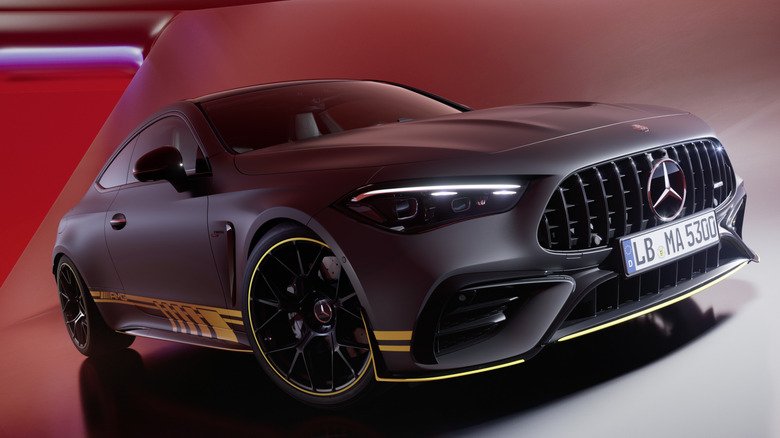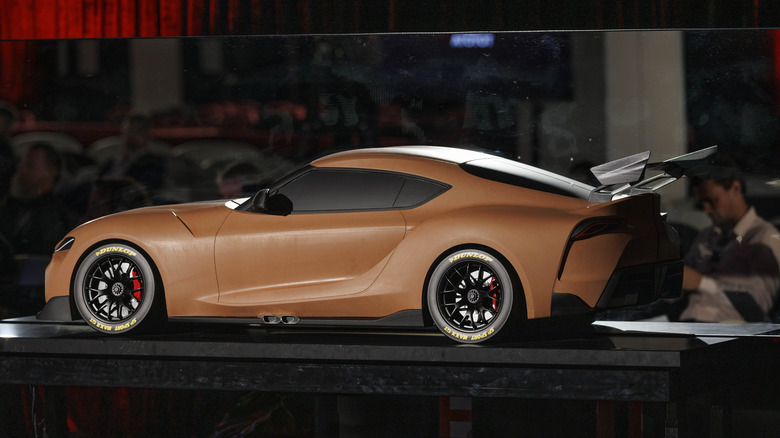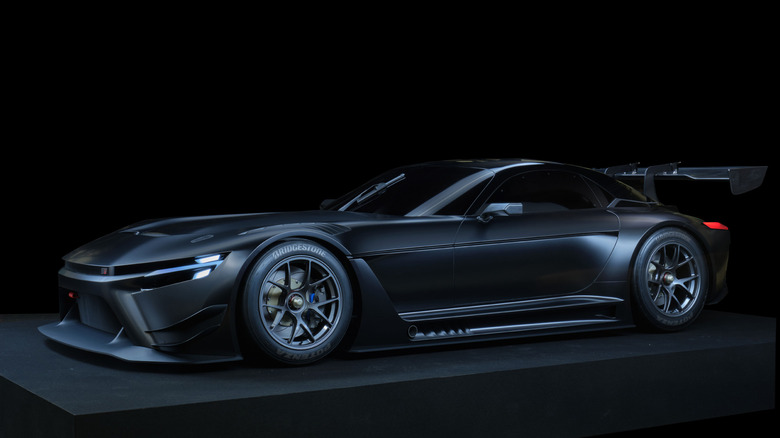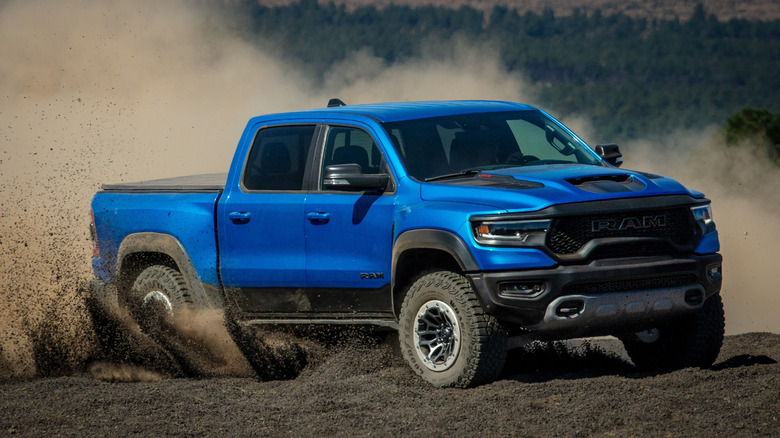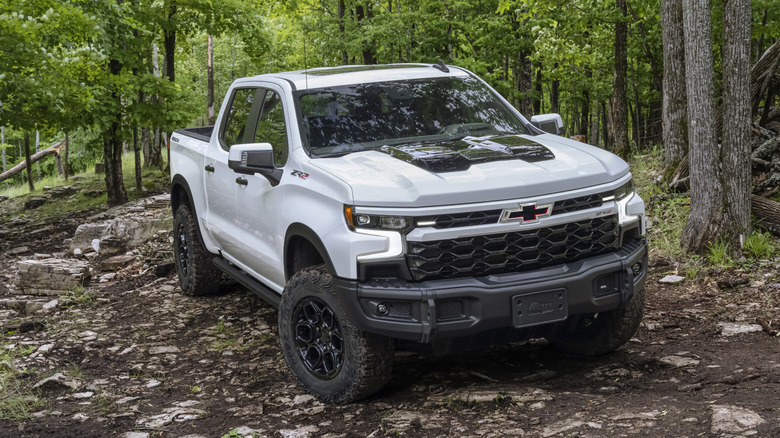The V8 Engine Isn't Dead Yet - These Are The Ones We're Most Excited For
These days, new cars are continually moving away from many of the most iconic internal combustion engines of the 21st century. Engines like the Audi and Lamborghini V10, third-gen Chrysler Hemi, Jaguar's lineup, and more have all met their demise within the past several years. Many manufacturers continue moving towards full electrification or adopting systems like hybrid V6 or turbocharged inline-four powerplants, which is without question the best decision as far as the environmental and economic perspectives are concerned. But where does that leave the good old V8? Certainly in a more niche position than it ever was, but one thing's for sure: V8s aren't dead. Not in enthusiast and hauling circles, anyway. In fact, various manufacturers still sell cars equipped with V8s.
These represent some of the best up-and-coming V8s announced with release dates in the next few years, ranging from upgrades to existing cars all the way to an engine equipping an entire model line. Similarly, some of these V8s are already well-established units, while others are fresh off the drawing board. But we look forward to them all the same, and can't wait to see these cars on the roads of tomorrow, undoubtedly blowing the doors off many more pedestrian models as intended. Let's dive right into it and take a look at what's coming up, starting with a familiar model receiving an interesting surprise under the hood for a bespoke racing variant.
Toyota Supra V8 Supercar
This is a car which was never associated with V8 powertrains in its lifetime, apart from the odd engine swap. Every Toyota Supra generation features an inline-six of some description, with each new iteration proving more powerful than the last. But in 2026, Toyota announced that it'll fit the Supra with a V8 for the first time, specifically a racing model for competition in the Australian V8 Supercars series. This specially-modified Supra will feature a 2UR-GSE V8 taken from the Lexus LC500, RC F, GS F, and IS F. It's an engine with a proven motorsports pedigree, powering the RC F GT3 which raced for a decade and is still competitive despite its age. In other words, this is a well-developed racing engine that's still fast enough to challenge top spots in the world's most prestigious events. And Toyota's putting it in a Supra.
The Toyota Supra boasts one of the most impressive racing legacies, including racing in Australia in the past. However, the majority of its competition today is relegated to either GT4 or Super GT, neither of which utilize a V8; in fact, the modern Supra GT500 uses a BMW inline-four. Yes, it's a powerful engine, but it has nothing on the howl of a V8 Supercar.
This will likely contribute to Toyota's ever-expanding motorsports program, but sadly it appears as though it'll remain motorsports-only, so don't expect any street legal Supra V8s anytime soon. Nevertheless, it's a Supra with a V8, what's not to love about that? Hence, why we can't wait to see it for real at its debut at the 2026 V8 Supercars season.
202X Toyota/Lexus GR GT
As mentioned previously, the Lexus RC F GT3 is an aged design, in fact it's one of the oldest cars competing in modern series like IMSA and WEC. But Toyota and Lexus Gazoo Racing weren't sitting idly that whole time. In fact, Toyota was cooking up a design that rivals some of the finest European grand tourers like the Mercedes-AMG GT: the Toyota GR GT. And with what it has under the hood, it's most certainly not just a superbly-beautiful automobile, but a fast one, too.
This monstrosity boasts a brand-new hybrid twin-turbo V8, and unlike the Supra, Toyota fully-intends this model for future mass-production. This car was unveiled back in 2022, though we've not heard much about it apart from rumors and spy footage citing a debut of 2026 in WEC. This indicates that the GR GT3 race car will replace the RC F GT3 as Toyota's premiere endurance racer. But that's not the best part.
Toyota Gazoo Racing stated a desire to race the car first, influencing its road car counterpart in the same way that the team developed the Lexus LFA. Basically, much like the LFA, this car will be a race car modified for road use, not the other way around. If you ever wanted a spiritual successor to the supercar and its iconic handbuilt V10 engine, the Toyota GR GT is that car. However, because the race car must be further refined first, don't expect the GR GT to hit the streets until 2027 at the earliest.
2026 Mercedes-AMG V8 Biturbo
Not to be outdone, Mercedes-AMG announced the continuation of their iconic V8 engines for 2026, in the form of a handcrafted 4.0-liter twin-turbo powerplant. Sadly, not every full-size AMG model will feature this new powertrain, with the most noticeable absence being the 2026 C63 AMG sedan, relegated to a hybrid six-cylinder instead. So if you want a V8-powered AMG, you'll likely have to purchase a two-door — namely, a CLE 63 AMG.
This move follows a controversial shift in the German luxury automaker's philosophy away from its larger-displacement powerplants towards four and six-cylinder layouts, and even the 4.0-liter V8 isn't without its detractors. It'll certainly raise a few eyebrows and beg questions regarding electrification and hybridization, considering Mercedes-AMG aren't above pulling stunts like artificial sound generation to mimic the characteristic burble of their older V8s in newer flat-plane powerplants. Additionally, there's the question of increasingly stringent European emissions regulations, no doubt contributing to the demise of the large-displacement engine.
It'll be up to Mercedes-AMG to resolve these differences and create a robust, powerful V8 with a deep growl while satisfying emissions standards, which is no small feat. That said, Mercedes-AMG have experience in extracting power out of small engines, such as its 2.0-liter hybrid inline-four producing a healthy 671 horsepower and 752 lb/ft torque. Effectively mating two such powertrains together to make a 4.0-liter V8 sounds like a tremendous idea to us. In short, yes, Mercedes-AMG is bringing back the V8, and we can't wait to see what it can do, hybrid or not.
2026 Chrysler Hemi resurrection
One of the most controversial decisions Stellantis made since acquiring Chrysler has been the discontinuation of the Hemi. In November 2023, Stellantis announced a move towards electrification of its Ram truck and muscle car lineup, putting an end to the current generation of Hemi and angering long-time fans, to the tune of plummeting sales figures across the truck lineup. The Hemi represented one of the victims of former CEO Carlos Tavares' aggressive restructuring campaign, which was criticized for being out of touch with its consumer base.
All that changed in 2025, when Stellantis announced a restart in Hemi production. The new Hemi will be assembled in the Saltillo Plant in Mexico, and maintain the same tried-and-true 5.7-liter, 6.4-liter, and 6.2-liter supercharged variants. What's most exciting of all, though, is that Dodge will fit at least one of these powerplants under the hood of the 2026 Charger. There's no word yet as to which Hemi specifically will find a home in the muscle car, though any Hemi is better than no Hemi, we say.
Moreover, truck fans will rejoice as well, as the Hemi returns to the Ram truck lineup, though it's not without its challenges. Namely, the Ram truck must undergo changes to accommodate the Hemi powertrain, with the earliest Hemi-equipped models rolling off the line for model year 2026. But it'll all be worth it, and as a bonus, the Ram TRX will boast the 797-horsepower supercharged Hellcat Redeye Hemi, marking the most power a TRX ever received with a factory warranty sticker.
GM sixth-generation V8
While most manufacturers are either recycling older designs or edging more towards electrification, GM placed a lot of eggs in their new V8 basket. 888 million eggs, to be precise; that's how much the company invested in its brand-new sixth-generation V8 powerplant. Moreover, GM contributed much of that money into Tonawanda Propulsion Plant in Buffalo, New York that will produce the new engine alongside the Flint Engine Plant in Michigan.
GM remain tight-lipped about this new powertrain, so we don't know much about it. However, the company has revealed that the small-block will find its way into full-size trucks and SUVs, with a production timeline starting in 2027 coinciding with the next-generation Chevrolet and GMC pickup lines. What's most exciting about this engine isn't specifically relating to its potential power figures, however. Rather, it relates to the vehicles it equips, and what that means in the big picture.
GM says it expects these engines to reduce emissions over current models, and while we again don't have exact figures, this shows that major companies are still willing to work with building the classic V8 powertrain for efficiency as well as performance. Naturally-aspirated V8s always featured several major draws over comparable hybrids and such. For instance, without the hybrid powertrain, a V8 is far simpler and more intuitive to work on yourself, generally-speaking. They also have a characteristic sound that can be further refined with aftermarket exhaust. And GM V8s are famously overengineered and upgradeable, which are some of the reasons LS engines are so special. Therefore, if it's more of the same, just with better efficiency and performance, then what's not to love?
